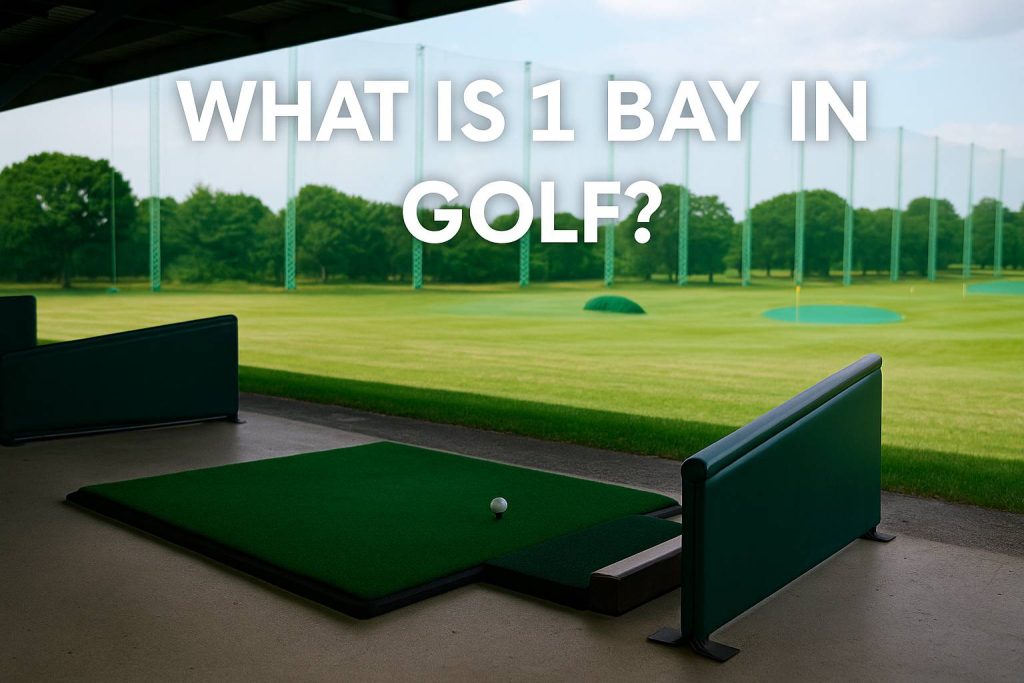In the world of golf training—particularly at driving ranges and simulator facilities—the term “1 bay” frequently comes up as a fundamental element supporting a golfer’s practice experience. Though it may sound simple, a bay in the context of golf plays a crucial role as a personal training space where players refine their technique and improve shot performance.
This article from GoGolf explores in detail what a “1 bay” means in golf, its physical characteristics, primary functions, and how it’s applied in various modern training setups. This understanding is especially useful for beginners, range managers, or even investors looking to build a professional golf training facility.
Definition of “1 Bay” in Golf

In golf, a “bay” refers to a single individual booth or station designated for one player at a driving range or golf simulator. This is the spot where the player stands and hits balls toward the range or a digital simulation screen. A bay is typically designed to support one golfer at a time, although it can occasionally accommodate two in a more casual setting.
The standard dimensions of a bay vary depending on the facility, but typically measure around 1.5 to 2 meters wide and 2.5 to 3 meters deep. This size provides enough room for a golfer to perform a full swing safely and comfortably. Bay design prioritizes safety, ergonomics, and space efficiency.
At modern facilities, a bay is more than just a physical space—it often includes digital technologies such as launch monitors, touchscreen interfaces, swing radars, motion analysis cameras, and advanced software that tracks and analyzes performance in real time.
Make golf booking effortless. Install GoGolf App now!
Primary Functions of a Golf Bay
A bay at the driving range is more than just a place to stand and hit balls. It is a strategically designed training station that caters to various needs of golfers. Here are the key functions of a golf bay:
1. Individual Practice Zone
The main function of a bay is to serve as a dedicated personal training space. Golfers can focus on fundamental techniques such as grip, stance, alignment, and swing path. Because each bay is isolated, players can concentrate without distraction from others.
In professional training environments, such as golf academies or national athlete development programs, each golfer is assigned their own bay. This allows for time efficiency and maximized productivity during structured practice sessions.
2. Equipment Testing Area
Golfers frequently use bays to test new clubs, balls with specific specs, or accessories like gloves and shoes. Practicing in a consistent bay environment helps players evaluate equipment performance accurately—especially when launch monitors are available.
Golf shops often feature fitting bays, specially designed spaces where players can be fitted for clubs based on swing stats and distance data.
3. Swing Evaluation Station
Bays are ideal for swing analysis, utilizing motion-capture cameras or swing radar analyzers. Players can review their swing videos to observe body positioning, club head speed, angle of attack, and ball spin rate. These data points are essential for performance improvement.
4. Game Simulation Experience
In golf simulators, a bay is not just a hitting space—it’s an immersive gaming zone. Players can select world-famous courses, play competitively, or enjoy gamified practice features.
Equipment and Facilities Commonly Found in a Bay
Even conventional driving ranges provide reasonably well-equipped bays, while professional and premium simulator venues offer more advanced features. Common components include:
1. Hitting Mats and Auto Tees
Bay floors are lined with high-quality synthetic mats that simulate real turf. Some modern facilities use automatic tee systems that adjust tee height according to player preference.
2. Club Racks and Seating
Each bay usually has a club rack for easy access to golf clubs, and a chair or bench so players can rest between swings or wait their turn.
3. Launch Monitors
These devices capture data such as ball distance, club speed, launch angle, and spin rate—vital for analyzing shot performance and optimizing club selection.
4. Swing Cameras and Data Displays
Advanced setups include swing cameras and digital displays showing real-time analytics, charts, and replay videos. These tools are particularly beneficial for seasoned golfers and professionals.
Types of Facilities That Use the Bay System
The bay concept has evolved and is now utilized in various types of golf facilities. Each facility offers a slightly different experience depending on user needs.
1. Traditional Driving Ranges
Outdoor driving ranges are the most common venues with bay systems. Dozens of bays are aligned side by side, and each golfer stands in a designated space with direct views of the practice field to observe shot distance and trajectory.
2. Indoor Golf Simulators
In indoor settings, bays are paired with simulators. Golfers hit balls into screens that visualize virtual golf courses. This is especially popular in countries with cold climates or in urban fitness centers.
3. Golf Entertainment Venues (e.g., Topgolf)
Entertainment-driven golf spots like Topgolf combine lounge-style setups with bay technology. Each bay includes sofas, dining tables, and ball-tracking systems. Visitors play fun game formats while enjoying food and drinks—making golf a social and accessible experience.
The Role of Bays in Modern Golf Industry Growth
In recent years, bay-based driving ranges and simulators have become central to the transformation of the golf industry. This model makes golf more inclusive, approachable, and enjoyable—especially for younger players.
From Exclusive to Accessible
Golf was once seen as an exclusive sport tied to expensive 18-hole club memberships. Now, thanks to the bay system and simulators, anyone can try golf without joining a club. This has broadened the market and revitalized the global golf scene.
A Time-Efficient Practice Option for Busy Golfers
Golfers with limited time can still fit in quality practice by booking a bay for 30–60 minutes. Bays allow for highly focused, distraction-free training sessions that make the most of players’ time.
Tech Innovations to Improve Skills
With tools like TrackMan, swing analyzers, and AI-powered feedback, modern bays deliver ultra-precise training environments. Even professional athletes now regularly use bays to sharpen their technique ahead of major tournaments.
Conclusion: A Small Space with Big Impact
A golf bay is far more than a small booth for hitting balls. It is a space for growth, experimentation, entertainment, and competition. From basic driving ranges to advanced simulators, the bay is the cornerstone for millions of golfers worldwide seeking to improve their game—or simply enjoy relaxing moments with friends and family.
For facility operators, understanding bay design and technology is essential to creating the best possible user experience. For golfers, recognizing the functions and potential of a single bay opens the door to more effective practice and sharper performance. And for beginners, the bay is the perfect place to fall in love with the game of golf.
[ Follow our social media Account: GoGolf Instagram | GoGolf Facebook | GoGolf X ]











